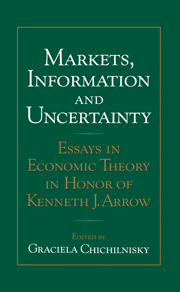Book contents
- Frontmatter
- Contents
- Preface
- List of contributors
- Section I Information and markets
- Section II Uncertainty and finance
- 3 The formulation of uncertainty: Prices and states
- 4 A remark on incomplete market equilibrium
- 5 Existence and optimality of a general equilibrium with endogenous uncertainty
- 6 Market equilibrium with endogenous price uncertainty and options
- 7 Catastrophe futures: Financial markets for unknown risks
- Section III Market externalities and justice
- Author index
- Subject index
7 - Catastrophe futures: Financial markets for unknown risks
Published online by Cambridge University Press: 05 December 2011
- Frontmatter
- Contents
- Preface
- List of contributors
- Section I Information and markets
- Section II Uncertainty and finance
- 3 The formulation of uncertainty: Prices and states
- 4 A remark on incomplete market equilibrium
- 5 Existence and optimality of a general equilibrium with endogenous uncertainty
- 6 Market equilibrium with endogenous price uncertainty and options
- 7 Catastrophe futures: Financial markets for unknown risks
- Section III Market externalities and justice
- Author index
- Subject index
Summary
Introduction
New risks seem to be unavoidable in a period of rapid change. The last few decades have brought us the risks of global warming, nuclear meltdown, ozone depletion, failure of satellite launcher rockets, collision of supertankers, AIDS, and Ebola. A key feature of a new risk, as opposed to an old and familiar one, is that one knows little about it. In particular, one knows little about the chances or the costs of its occurrence. This makes it hard to manage these risks. Existing paradigms for the rational management of risks require that we associate frequencies to various levels of losses. This poses particular challenges for the insurance industry, which is at the leading edge of risk management. Misestimation of new risks has led to several bankruptcies in the insurance and reinsurance businesses. In this chapter we propose a novel framework for providing insurance cover against risks whose parameters are unknown. In fact many of the risks at issue may not be just unknown but also unknowable. It is difficult to imagine repetition of the events leading to global warming or ozone depletion, and therefore difficult to devise a relative frequency associated with repeated experiments.
A systematic and rational way of hedging unknown risks is proposed here, one which involves the use of securities markets as well as the more traditional insurance techniques. This model is consistent with the current evolution of the insurance and reinsurance industries, which are beginning to explore the securitization of some aspects of insurance contracts via Act of God bonds, contingent drawing facilities, catastrophe futures, and similar innovations. Our model provides a formal framework within which such moves can be evaluated.
- Type
- Chapter
- Information
- Markets, Information and UncertaintyEssays in Economic Theory in Honor of Kenneth J. Arrow, pp. 120 - 140Publisher: Cambridge University PressPrint publication year: 1999



